During water drive development, the formation pressure of low permeability reservoirs is often kept at a low level. Can gas injection quickly replenish the energy of low permeable reservoirs? Can miscible gas flooding substantially increase the daily oil rate? Will gas injection affect the properties of oil produced, and how does the composition of produced oil change? What is kind of factors influencing the change of gas drive producing performance and the basis of gas flooding development stages division. After more than ten years of field gas drive practice in China, some important understandings have been obtained.
Keywords: Gas flooding, Field practice, Understandings
After about half a year between the small wells in Hei59 and Hei79, formation energy increases rapidly, exceeding the minimum miscible pressure of 22.3MPa, formation energy is quickly supplemented by gas injection, and miscible flooding is realized. Taking the small well spacing pilot test of North block Hei79 as an example, the reservoir began to inject gas with high water cut, the average well oil production rate increased from 0.8 ton per day to 1.35 ton per day. The water cut of the whole well group decreased greatly, the production rate of liquid was relatively stable, showing the characteristics of miscible displacement, and the incremental recovery factor would be up to 13% accordingly. After the gas injection into south block Hei79, the output stopped falling and rose again, and the effect of increasing oil rate was obvious Figure 1.
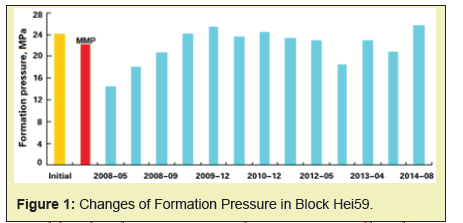
Laboratory core displacement experiments show that miscible flooding can greatly improve oil microcosmic displacement efficiency; field gas injection practice shows that miscible flooding can greatly improve single well oil production rate and stage recovery factor. For those miscible flooding projects, and the increment range of different reservoirs may vary greatly. The oil production rate multipliers due to gas flooding exceed 3.0 in Pucheng Sha3 water drive limit reservoir in Zhongyuan oilfield; the oil production rate multipliers of block Hei59 in Jilin oilfield as secondary production mode are 1.5; the oil production rate multipliers of carbon dioxide miscible flooding are about 1.7 in block Bei14, which is not suitable for water injection; and the oil production rate multipliers of Donghe natural gas drive project in Tarim oilfield are about 1.68; the oil production rate multipliers in North Hei79 high water-cut reservoir in Jilin oilfield being 1.75. In theory, there should be many factors affecting the oil rate performance of gas drive in low permeability reservoirs. At present, the reliability of multi-component gas drive numerical simulation in low permeable reservoirs is worth worrying. The author statistics, the error of predicting oil production by numerical simulation of low permeability reservoirs in China is more than 50%, close to 60%. It is an important problem to analyze the main controlling factors of gas drive effect and explore other methods of gas drive production prediction.
In the early stage of gas flooding, the component composition of produced formation oil changed, mainly with the increase of light component content and the decrease of heavy component content. The physical properties of formation oil are improved correspondingly, which is more conducive to flow. In the early stage of natural gas flooding in DHT of Tarim, the content of recombinant oil decreased obviously, while the content of light-medium component C7-10 tended to increase Figure 2. Similar changes have taken place in the composition of the produced oil of the CO2 flooding effective wells in Shu101 Oilfield, Daqing.
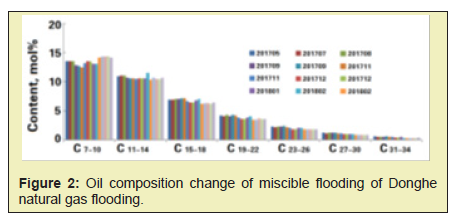
This is also observed by the indoor experiment of dynamic contact. The oil phase at the back edge of the transition zone or "oil bank" expands first and then shrinks; the gas phase shrinks first and then expands slightly; the volume shrinkage of the oil phase increases with the increase of pressure, and the gas phase changes little. It is precisely because of the decrease of light components in the back edge of the oil wall which contacts the gas first that the volume of oil phase expands, the viscosity decreases and the fluidity improves in the front edge of the gas drive. Similar phenomena can be found in air flooding. After entering the gas emergence time of the Haita air flooding pilot in Daqing, the content of light components in the produced oil increases, while the content of much heavier components (such as C13-25) decreases. The composition of formation oil will also change under the influence of oxidation reaction Figure 3.
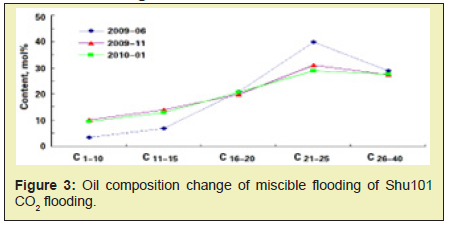
Practice shows that gas injection may cause water cut change in producers. The water cut of the reservoir in the small well spacing pilot area of North block Hei79 in Jilin oilfield decreased from 86% to about 75%. After CO2 miscible flooding, the producing water-oil ratio of Little Creek Meakin Sand unit decreased from about 20 to about one. The comprehensive water cut of Donghe natural gas miscible flooding in Tarim Oilfield has decreased from 65% to 46%. There is no obvious change in the comprehensive water cut in the test area of carbon dioxide miscible flooding in Haita basin bei14 pilot area, Daqing. The main reason is that the initial water cut is close to zero, and the original formation water is basically in the irreducible state, which is immovable. It should be an objective phenomenon that different water cut changes in reservoirs at different development stages after gas injection. It is also of practical significance to study the prediction method of water cut change in gas drive Figure 4.
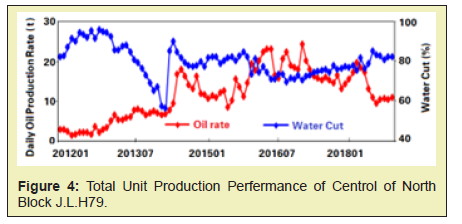
There are many physical fields in the displacement process of gas injection into oil reservoirs, such as pressure field, fluids distribution field or fluids saturation field, temperature field, rock stress field, electrochemical reaction field, etc. The coupling and evolution of these physical fields together determine the time and quantity of fluids produced, the temperature and pressure of the produced fluids, and the composition of the fluid itself and composition of the dissolved substances in them. Each physical field has its own moving front, such as the moving front of pressure field, the moving front of displacement medium field and the front of temperature transferring. The movement front of these physical fields directly causes remarkable changes of the producing performance of gas flooding, and promotes the producing performance to enter a new stage. For example, because the pressure propagates faster than the fluids seepage velocity in the reservoir matrix, the dynamic work fluids level caused by the formation energy gathering near the producers will rise earlier than the produced injected gas. Another example, because the temperature front of low temperature oxidation in air flooding propagates slowly than the fluid seepage speed, the effect of low temperature oxidation on increasing oil production rate may not been observed after injected air has been produced Figure 5.
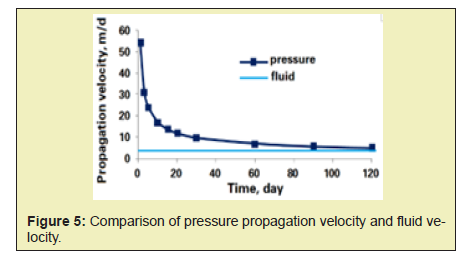
The practice of gas injection shows that producing effects of gas drive can be obviously improved by adopting the method of injection-production linkage adjustment. When compiling the detailed implementation plan of CO2 flooding of block Hei59 pilot in Jilin oilfield in 2008, considering the highly uneven producing performance of gas flooding caused by the strong geological heterogeneity, the author first summarizes the technical ideas of gas injection planning as "HWAG-PP" mode. Among them, "HWAG" means to a large gas slug followed by the smaller gas slugs sequence during the water-gas alternating injection stage. The methods to reduce the gas slug include reducing the daily gas injection rate or shortening the injection time. Cyclic or pulsed gas injection can be regarded as a special kind of "HWAG" with infinite daily water injection rate during the water slug injection period. "PP" refers to periodic production of producers. It is a way to suppress gas channeling by means of intermittent switch or flowing pressure control of producers. The "HWAG-PP" mode is a method of controlling gas channeling by injection-production linkage adjustment, expanding sweeping volume and improving development effects. The essence of this technology mode is as follows: water alternating gas injection in injectors can inhibit gas channeling and enlarges sweeping volume by bettering fluidity ratio; periodic production in producers can enhance oil displacement efficiency by strengthening miscibility and suppress gas channeling to expand sweeping volume by controlling producing pressure difference. "HWAG-PP" mode has been applied in the production of Qingzijing oilfield CO2 drive industrial test in Jilin province, and Yushulin oilfield and Haita oilfield CO2 drive industrial test area in Daqing.
The development stage of gas drive can be divided according to gas injection mode, producing performance characteristics and flowing field change characteristics. Generally speaking, the formation pressure can be restored to a considerable level by continuous gas injection for several months to one year or so. In this so-called pressure building up stage, the "oil bank" also develops and forms. Then the whole performance enters the gas emergence stage, and the "oil bank" with high oil saturation in the underground flowing field begins to be centralized produced. The production manifestation is the start of stable peak oil production rate period of gas displacement. The appropriate HWAG-PP production mode of combining water alternating gas injection with periodic production of high gas oil ratio producers is adopted. Then entering the dispersed recovering stage of "oil bank" or gas channeling with high gas oil ratio, the gas drive effects should be maintained with more vigorous production adjustment measures to enlarge sweeping volume by injection-production linkage adjustment, which will be quite a long period. In the final stage, the gas drive effect will become poor and may not be economical to continue gas injection. Subsequent water flooding should be considered to ensure economical effective benefits. The centralized recovering stage of "oil bank", also the most obvious stage of gas drive effect, is subordinate to the gas emergence stage of gas flooding. The recovery time of "oil bank" can be divided into two stages: the first stage is concentrated recovering of ''oil bank''; the second stage is dispersed recovering stage of "oil bank", which is mainly controlled by the intensity of development adjustment measures. "Oil bank" centralized recovering stage belongs to the peak oil rate period after gas emergence and the dispersed recovering stage of belongs to the stage of gas breakthrough or gas channeling. Therefore, the concept of "oil bank" centralized recovering time is proposed to quantitatively describe the duration of oil bank centralized recovering stage, which is also approximately equal to the peak oil rate period or the time from gas emergence to overall gas channeling. Of cause, in the early stage of gas channeling, if the production technology and development adjustment measures are appropriate, the peak oil rate period can still be effectively prolonged. The description of geometric features of gas drive "oil bank" can help to determine the length of stable oil rate period of gas flooding. The key to quantitatively dividing gas flooding development stages are to determine the time of gas emergence and length of stable oil rate period of gas flooding.1-4
None.
None.
No potential conflicts of interest with respect to the research, authorship, and/or publication of this article.
- 1. Stalkup FI, Stein M H, Lake L W, et al. CO2 Flooding [M]. Texas: Society of Petroleum Engineer. 1998.
- 2. China Petroleum Oil and Gas and New Energy Branch. Guidelines on Preparation and Management of CCUS-EOR Development Plan of Petro China [J]. CNPC, 2022,11.
- 3. Gaofeng Wang, Xiongjie Zheng, Yu Zhang. A new screening method of low permeability reservoirs suitable for CO2 flooding. Petroleum Exploration& Development. 2015;42(3):358-363.
- 4. Gaofeng Wang. New Theory of Gas Emergence Time Prediction in Gas Flooding Tight Reservoirs. Journal of Science Technology and Engineering. 2014;14(34):18-23.

